Abstract
In recent years, high-power white light-emitting diode (wLED)/laser diode (wLD) lighting sources based on transparent phosphor ceramic (TPC) materials have attracted increasing application interest in automotive headlights, projection displays, and space navigation lighting due to their superior brightness, lighting distance, compactness, lifespan, and environmental resistance compared with the widely used phosphor-converted wLEDs. However, preparing TPC-converted wLEDs/wLDs with high color rendering index (CRI) remains a huge challenge, which limits their widespread application. In this review, we summarize the recently adopted strategies for constructing TPCs to develop high-power wLEDs/wLDs with high CRI values (>75). The construction protocols were categorized into four groups: host regulation, red-emitter doping, host regulation/red-emitter doping combination, and composite structure design. A comprehensive discussion was conducted on the design principles, photoluminescent properties, and device performances for each strategy. The challenges and future trends of high-power and high-CRI wLEDs/wLDs based on TPCs are also discussed toward the end of this review.
1. Introduction
The first decades of this century have witnessed an extraordinary revolution in the lighting industry, as blue light-emitting diodes (LEDs) were cleverly combined with yellow Y3Al5O12:Ce3+ (YAG:Ce3+) phosphors dispersed in organic resins to generate white light [1]. Due to their advantages of low energy consumption, non-pollution, and long service life, these phosphor-converted white LEDs (pc-wLEDs) have quickly replaced traditional incandescent and fluorescent lamps in a short time to become the mainstream lighting sources [2,3,4]. However, the thermal conductivity of organic resins is low, and thermal degradation occurs under the accumulated thermal radiation of the LED chip, which inevitably reduces the luminous efficiency (LE) and color quality of the pc-wLED devices during long-term use [5,6,7]. As the power of LEDs increases, this problem will worsen significantly. In order to achieve high-power lighting, alternative color converters with high thermal conductivity and strong resistance against thermal degradation are required.
Recently, a range of color converters for high-power wLEDs or white laser diode (wLD) lighting devices have been reported, including phosphor films [8,9,10,11,12], phosphors in glass [13,14,15,16,17,18,19,20,21,22], glass ceramics [23,24,25,26,27], single crystal phosphors [28,29,30,31,32,33], and transparent phosphor ceramics (TPCs) [34,35,36,37,38]. Among them, TPCs have gained particular attention due to their high thermal conductivity, excellent heat resistance, high mechanical strength, high homogeneity, and high LE [34,35,39,40,41]. The first TPC-converted wLED was reported in 2008 [42], in which YAG:Ce3+ ceramic was used. Since then, YAG:Ce3+ TPCs have been widely studied, and have shown broad application prospects in automotive headlights, projection displays, space navigation lighting, and other fields. However, the wLEDs/wLDs constructed with YAG:Ce3+ TPCs show low color rendering index (CRI) due to the lack of red emission component [34,38,40,43], which restricts their practical application.
To address the issue, many approaches to enhance the CRI values of YAG:Ce3+ TPC-converted wLEDs/wLDs have been explored in recent years. However, a systematic summary of this topic is still lacking. With the growing research interest in high-power and high-CRI lighting [16,44,45,46], a summary of the latest research results in this aspect is meaningful for junior researchers who are going to start their research in this area. Therefore, this review comprehensively summarizes the reported preparation methods for TPCs for constructing wLED/wLD lighting sources with high power and high CRI values (>75). The construction strategies were divided into four general categories: host regulation, red-emitter doping, host regulation/red-emitter doping combination, and composite structure design. For each strategy, design principles, photoluminescent (PL) properties, PL tuning mechanisms, and device performances were extensively discussed. Finally, the current challenges and future prospects of high-power and high-CRI wLED/wLD lighting systems are also presented. We believe that a comprehensive summary of construction strategies from foundation to application will benefit junior researchers in developing advanced lighting systems.
2. Modifying the YAG Host to Redshift the Emission or/and Widen the Emission Band of Ce3+
As a well-known phosphor host, YAG has a garnet structure (Figure 1) with a general formula of Y3Al(1)2Al(2)3O12, where Y, Al(1), and Al(2) are coordinated with 8, 6, and 4 oxygen atoms to form a dodecahedron, octahedron, and tetrahedron, respectively. The most widely used yellow phosphor YAG:Ce3+ is obtained by replacing a proportion of the Y3+ ions with Ce3+. Through further substitution/co-substitution of proper cations on the Y, Al(1), or Al(2) sites, the crystal field of the host lattice can be tailored, which results in PL tuning of YAG:Ce3+. Notably, the cation substitution occurs only when the coordination numbers (CNs) are equal and the ionic radii are similar. In order to better understand all material systems in this review, the ionic radii for a given CN of all relevant ions are listed in Table 1.
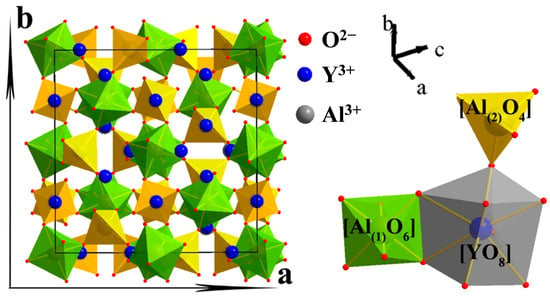
Figure 1.
The crystal structure (left) of Y3Al5O12 and the coordination environment of Y3+ and Al3+ cations (right) in the lattice. Reprinted with permission from ref. [47]. Copyright 2014, American Chemical Society.

Table 1.
The ionic radii (Å) for a given CN of all relevant ions in this review refers to the YAG lattice.
For YAG:Ce3+-based photo-converters, an effective way to add red emission components to their PL spectra is to adjust the crystal field of the 5d orbital of Ce3+, which is capable of shifting the emission peak of Ce3+ to longer wavelengths or/and broadening the full width at half maximum (FWHM) of the emission band. This can be accomplished by modifying the YAG garnet host via two general technical approaches: one is to replace the dodecahedral Y3+ site with ions with larger ionic radii, such as Gd3+ or Tb3+; the other is to replace octahedral/tetrahedral Al3+ with Ca2+-Si4+, Mg2+-Si4+, or Mg2+-Ge4+ ion pairs with longer bond lengths [48,49,50,51,52,53]. Using this strategy, a series of YAG:Ce3+-based ceramics with high CRI have been reported.
In 2011, Nishiura et al. [54] synthesized a series of transparent (GdγY1-γ)3Al5O12:Ce3+ (γ = 0–0.75) ceramics with thicknesses of 0.1–1.1 mm through the vacuum sintering technique. The 5d1 → 4f transition of Ce3+ led to broad PL emission bands for all samples. As the content of Gd3+ increased, the peak of the emission bands shifted from 530 nm to 560 nm (Figure 2a), and the sample color changed from greenish yellow to yellow, which can be attributed to the increase in crystal field splitting (CFS) upon the substitution of Y3+ with Gd3+. Under the excitation of a 465 nm LED, the color coordinates shifted from blue to the yellow or orange region upon increasing the thickness of the samples from 0.1–1.1 mm (Figure 2b). For samples with same thickness, the color coordinates redshifted with the increase of Gd3+ content. When connecting the color coordinates of the sample with the same Gd3+ content with a straight line, it was found that the straight lines of (GdγY1−γ)3Al5O12:Ce3+ (γ = 0.25–0.75) passed through the theoretical white point of (0.33, 0.33), while that of the YAG:Ce3+ ceramic did not. In other words, by the substitution of Gd3+ for Y3+, the emission color can be adjusted to pure or warmer white upon optimization of the sample thickness. As summarized in Figure 2c, with the increase of the Gd3+ content, the CRI value of the samples increased from 65 to 81, indicating their suitability as promising candidate color converters for high-power wLED/wLD lighting.

Figure 2.
(a) PL and PL excitation (PLE) spectra of the (GdγY1−γ)3Al5O12:Ce3+ (γ = 0–0.75) ceramics. (b) Chromaticity color coordinates of the samples under 465 nm LED excitation. (c) Gd content dependence of CRI and correlated color temperature (CCT) of the Ce:GdYAG ceramics. Reprinted with permission from ref. [54]. Copyright 2011, IOP Publishing.
To further investigate the LE of the material, in 2015, Chen et al. [55] also introduced Gd3+ into YAG:Ce3+ ceramics. The extent of redshift of the PL peak was proportional to the doping concentration of Gd3+. When combined with the InGaN blue chip, a CRI of up to 78.1 and a LE of 128.15 lm/W were obtained at an optimal Gd3+ concentration of around 10%.
Taking advantage of the rich red emission components and readily adjusted luminescent properties of (Gd,Y,Lu)3(Al,Ga)5O12:Ce3+ garnets [56], Liu et al. [57] designed and synthesized a series of highly transparent Gd3Al4GaO12:xCe3+ (GAGG:xCe3+, x = 0.25–1.00%) ceramics with thicknesses of 0.45, 0.65, 0.85, and 1.05 mm by sintering under an oxygen atmosphere. The broad emission bands (FWHM = 133–137 nm) and abundant red emission components (λem = 568–574 nm) of the GAGG:xCe3+ ceramics enable warm white light upon excitation by blue LED or LD chips (Figure 3a–h,a’). According to Figure 3b’–h’, with the increase of the concentration of Ce3+ or thickness of the samples, more and more blue light emitted from the chips was absorbed, resulting in an increase in the emission ratio of GAGG:Ce3+. As a result, the white emission color shifted from cool to warm and the CRI reached 78.9. When fabricating GAGG:0.75%Ce3+ ceramic (thickness = 1.05 mm) with a 445 nm blue LD of 2 W, the strong blue light (Figure 3i, left) changed to warm white with a CCT of 3053 K (Figure 3i, right), indicating the feasibility of the material for high-power wLEDs/wLDs with a comfortable warm white light.
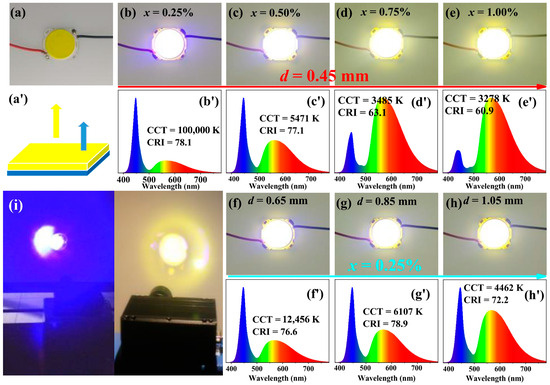
Figure 3.
(a–h,a’) Photographs of GAGG:xCe3+ ceramics on InGaN-based blue chips. (b’–h’) Electroluminescent spectra, CCT, and CRI of the obtained WLEDs. (i) Images of a 445 nm blue LD with 2 W (left) and a prototype wLD combining the blue LD and the GAGG:0.75%Ce3+ ceramic (thickness(d) = 1.05 mm) in operation (right). Reprinted with permission from ref. [56]. Copyright 2019, American Chemical Society.
In 2020, Sun et al. [58] selected Lu2Mg2Al2Si2O12:Ce3+ (LMAS:Ce3+) phosphor with a broad emission band (λem = 575 nm, FWHM = 144 nm) [59] and synthesized LMAS:Ce3+ phosphor ceramic using the vacuum sintering technique. As shown in Figure 4a, a series of LMAS:xCe3+ (x = 0.02–0.12) ceramic plates (diameter of 11 mm, thickness of 1 mm) was prepared. The samples showed broad emission bands spanning 475–800 nm when excited at 455 nm (Figure 4b), which could be ascribed to the 5d1 → 4f transition of Ce3+ ions (occupying the dodecahedral Lu3+ sites). When x = 0.08, the emission intensity reached the maximum value, displaying a broad yellow-orange peak at 565 nm with a FWHM of 130 nm. According to the thermal quenching properties shown in Figure 4c, the emission intensity of the LMAS:0.08Ce3+ ceramic plate at 150 °C decreased to 81.0% of the intensity at room temperature, while the pure LMAS:0.08Ce3+ phosphor decreased to 74.7% [59], indicating superior thermal stability of the ceramic plate compared with the phosphor. wLD light was obtained when LMAS:Ce3+ ceramic plates were fabricated with a blue LD in reflection mode (Figure 4d). When the laser power increased from 1 W to 3.3 W, the LMAS:0.08Ce3+ ceramic plate exhibited high CRI values (76.0–77.7) in consequence of the broadband emissive characteristic (Figure 4e,f).
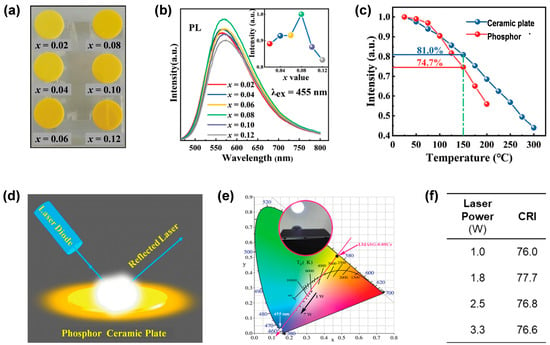
Figure 4.
(a) Image of LMAS:xCe3+ ceramic plates under daylight. (b) PL spectra (λex = 455 nm) of LMAS:xCe3+ ceramic plates. The inset shows the variation of PL peak intensities with different x values. (c) Temperature-dependent PL peak intensities of the ceramic plate and the phosphor of LMAS:0.08Ce3+. (d) Sketch map of wLD lighting with a reflection mode. (e) Chromaticity coordinates of the LMAS:0.08Ce3+ ceramic plate excited by different laser powers. Inset, a wLD device that has a maximum CRI of 77.7. (f) CRI of the LMAS:0.08Ce3+ ceramic plate driven by different laser powers. Reprinted with permission from ref. [58]. Copyright 2020, The Royal Society of Chemistry.
3. Co-Doping Red-Emitting Cr3+, Pr3+, or Mn2+ Ions into YAG:Ce3+
Another approach to supplement the red-emission component of YAG:Ce3+ ceramics is to co-doping red-light-emitting ions such as Cr3+, Pr3+, or Sm3+ into the phosphor ceramic material.
3.1. Co-Doping Cr3+ Ions into YAG:Ce3+
In 2021, Lu et al. [60] prepared Ce3+ and Cr3+ co-doped Al2O3-YAG eutectics through the micro-pulling-down method. X-ray diffraction (XRD) and scanning electron microscopy and energy dispersive spectroscopy (SEM-EDS) results showed substitution of Y3+ with Ce3+ and occupation of octahedral Al3+ sites by Cr3+. The co-luminescence of Ce3+ (λem = 543 nm, 5d1 → 4f transition) and Cr3+ (λem = 694 nm, 2E → 4A2 transition) ions in Al2O3-YAG:Ce3+,Cr3+ significantly enhanced the red-emission component. However, since the emission band of Ce3+ overlapped with the absorption band of Cr3+, energy transfer occurred from Ce3+ to Cr3+, which quenched the yellow emission of Ce3+. TPC converted LED based on Al2O3-YAG:Ce3+,Cr3+ emitted only blue light from the LED chip and red light from Cr3+ ions. To address the issue, an Al2O3-YAG:Ce3+ and Al2O3-YAG:Cr3+ stacked TPC converted WLED was fabricated, the CRI of which reached 78.7.
In 2022, Liu et al. [61] further investigated the influence of Cr3+ doping concentration on the luminescent properties of Ce/Cr co-doped Al2O3/YAG eutectic phosphor ceramics. The ceramics were prepared and fabricated through high-temperature sintering and the laser floating zone melting method. Upon adjustment of the concentrations of Cr3+ (0.2–0.8 wt%), the Ce3+ → Cr3+ energy transfer and luminescent properties of the ceramics were finely tuned. As shown in Figure 5a, after Cr3+ doping, strong red light emission centered at 694 nm appeared, which increased with the increase in Cr3+ concentration. At the same time, the emission intensity of Ce3+ around 550 nm decreased dramatically due to enhanced energy transfer from Ce3+ to Cr3+. As the concentration of Cr3+ increased, CRI first increased and then gradually decreased (Figure 5b), which can be rationalized by the suppression of yellow light emission. When the concentration of Cr3+ was equal to 0.4 wt%, CRI reached a maximum value of 80. Despite the improvement in CRI, overall LE declined (Figure 5b).
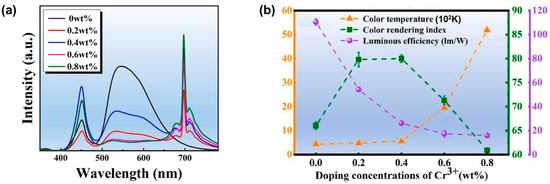
Figure 5.
(a) The electroluminescent spectra of Ce/Cr co-doped Al2O3/YAG eutectic ceramics with different doping concentrations of Cr3+. (b) The CRI, CCT, and LE data of ceramics under a 175 mA driving current. Reprinted with permission from ref. [61]. Copyright 2022, Elsevier.
In 2023, Li et al. [62] prepared Y2.94Al5−xO12:0.06Ce3+,xCr3+ (x = 0.004, 0.029, 0.054, 0.079, 0.104 mol) ceramics, in view of the wide emission band of Cr3+ spanning from 650 to 750 nm. As shown in Figure 6a, weak emission bands from 675 to 720 nm appeared upon the doping of Cr3+ into YAG:0.06Ce3+ ceramics. With the increase in the Cr3+ content, the CRI displayed a remarkable increase from 65.1 to 79.4 (Figure 6b). Therefore, the Ce3+, Cr3+ co-doped garnet ceramics are promising candidates for high-CRI lighting applications of wLEDs/wLDs.
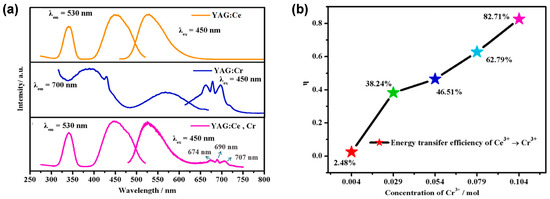
Figure 6.
(a) PLE and PL spectra of YAG:Ce3+ (yellow), YAG:Cr3+ (blue), and YAG:Ce3+,Cr3+ (magenta). (b) CRI change trend graph of Y2.94Al5−xCrxO12:0.06Ce3+ (x = 0.004, 0.029, 0.054, 0.079, 0.104 mol). Reprinted with permission from ref. [62]. Copyright 2023, Elsevier.
3.2. Co-Doping Mn2+ Ions into YAG:Ce3+
As summarized in Table 1, Mn2+ possesses multiple coordination numbers (CN) and feasibly occupies the tetrahedral Al3+ site, octahedral Al3+ site, and the dodecahedral Y3+ site in YAG host. Due to the spin-forbidden 4T1 → 6A1 d-d transition of Mn2+ into different occupation sites in the YAG lattice, the emission of Mn2+ can span from green to deep red depending on the specific coordination environment. In particular, Mn2+ at the octahedral position emits orange-red light, which is beneficial for promoting CRI. In this regard, Ao et al. [63] introduced Mn2+ into YAG:Ce3+ ceramics by preparing a series of Y2.994Ce0.006Al5−2xMnxSixO12 (YAG:Ce3+,xMn2+,xSi4+) (x = 0, 0.01, 0.02, 0.04, 0.08, 0.16) ceramics via solid-state reaction under vacuum conditions (Figure 7a). The co-doping of Si4+ was for charge compensation. XRD data, together with the PL properties of Y3Al4.98Mn0.02O12, indicated that Mn2+ ions tended to occupy the position of octahedral Al3+, while Si4+ ions were located at the position of tetrahedral Al3+. As shown in Figure 7b, upon the doping of Mn2+/Si4+ pairs, the green emission band of Ce3+ (535 nm) as well as orange (587 nm, Mn2+ occupying the octahedron Al3+ site) and red (740 nm, Mn2+ occupying the dodecahedron Y3+ site) emission bands were observed, indicating the successful complementing of the red emission. It is worth noting that the emission band centered at 740 nm exceeds the cutoff wavelength (690 nm) of CIE 1931 color matching function, as the human eye cannot effectively perceive anything beyond 690 nm. Therefore, in wLEDs/wLDs, only the orange-red emission at 587 nm has significance in improving the CRI. As the concentration of Mn2+/Si4+ pairs increased, the emission intensity of Ce3+ decreased, while the emission intensity ratio of Mn2+ to Ce3+ increased (Figure 7b). The results indicate efficient energy transfer from Ce3+ to Mn2+, which is further evidenced by the shortened lifetime of Ce3+ in fluorescence lifetime decay studies. This energy transfer facilitates the realization of tunable emission color from yellow toward the orange-red region, as demonstrated by the changes of CIE chromaticity coordinates (x, y) in Figure 7c,d. When x = 0.16, a CRI as high as 75 was obtained, which is promising for warm white light application.
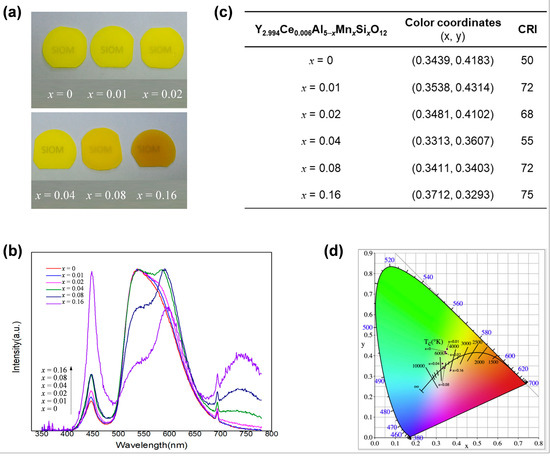
Figure 7.
(a) Photograph of the YAG:Ce3+,xMn2+,xSi4+ (x = 0, 0.01, 0.02, 0.04, 0.08, 0.16) phosphor ceramics. (b) Electroluminescent spectra of YAG:Ce3+,xMn2+,xSi4+ coupled with 450 nm GaN blue chips. (c) The color coordinates and CRI of the packaged LEDs. (d) The CIE chromaticity diagram of YAG:Ce3+,xMn2+,xSi4+ samples. Reprinted with permission from ref. [63]. Copyright 2019, Elsevier.
3.3. Co-Doping Cr3+ and Pr3+ Ions into YAG:Ce3+
Pr3+ ion is a well-known orange-red light emitter upon irradiation of blue LEDs. Therefore, similar to the Ce3+,Cr3+ co-doped garnet ceramics, the doping of Pr3+ into YAG:Ce3+ ceramic can also supply the red spectral component and improve CRI performance. In 2017, Feng et al. [64] introduced both Cr3+ and Pr3+ into YAG:Ce3+ ceramics to expand the emission spectrum. The YAG:Ce3+,Pr3+,Cr3+ ceramics were prepared through a solid-state reaction–vacuum sintering approach. The introduction of Pr3+ and Cr3+ changed the yellow color of YAG:Ce3+ ceramic to orange-yellow and yellow-green (Figure 8a). Analysis of the XRD diffraction patterns confirmed that Ce3+ and Pr3+ occupied the position of Y3+, and Cr3+ resided on the position of octahedral Al3+. Under 450 nm excitation, characteristic emission peaks of Ce3+, Pr3+, and Cr3+ at 530, 609, and 689 nm appeared, enabling wide emission spectra spanning 500 to 750 nm (Figure 8b). Investigation of the fluorescence decay curves confirmed energy transfers of Ce3+ → Pr3+ and Ce3+ → Cr3+, consistent with the studies by Lu et al. [60]. Through systematic optimization of the doping concentration of Ce3+, Pr3+, and Cr3+, high-quality white light with CRI reaching 78 (Figure 8c) was obtained by fabricating the YAG:Ce3+,Pr3+,Cr3+ ceramics with blue LED.
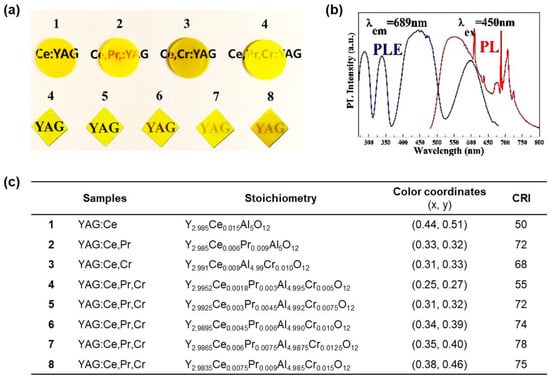
Figure 8.
(a) Picture of as-prepared transparent ceramics 1–8. (b) PL and PLE spectra of YAG:Ce3+,Pr3+,Cr3+. (c) Ingredients, color coordinates, and CRI of all the transparent ceramic packaged LEDs. Reprinted with permission from ref. [64]. Copyright 2017, Elsevier.
3.4. Co-Doping Pr3+ and Mn2+ Ions into YAG:Ce3+
In view of the orange light emission from Mn2+ and red light emission of Pr3+, Ma et al. [65] doped Mn2+ and Pr3+ synchronously into YAG:Ce3+ ceramics using a solid-state vacuum sintering technique. Due to the similarity of ion radii, in the YAG lattice, Pr3+ (1.126 Å, CN = 8) occupied the position of dodecahedral Y3+ (1.019 Å, CN = 8), while Mn2+ (0.67 Å, CN = 6) took up the position of octahedral Al3+ (0.535 Å, CN = 6), which was further confirmed by XRD patterns. The as-prepared single-structured YAG:Ce3+,Mn2+,Pr3+ ceramics exhibited typical emission peaks of Ce3+ (545 nm), Mn2+ (580 nm), and Pr3+ (609 nm) in the fluorescent spectra (Figure 9a). As the concentrations of Mn2+ and Pr3+ were adjusted, the FWHM of the emission spectrum increased from 91.7 nm to 102.2 nm (Figure 9b), which was conducive to achieving high CRI. When YAG:Ce3+,Mn2+,Pr3+ ceramics were assembled with a blue LED, the obtained CRI of the wLED device reached 84.8 for Pr02Mn08 (Figure 9c).

Figure 9.
(a) Normalized PL spectra and (b) the FWHM evolution of the PL spectra of the prepared ceramics. (c) Ingredients, color coordinates, and CRI of all the ceramic packaged LEDs. Reprinted with permission from ref. [65]. Copyright 2020, The Royal Society of Chemistry.
4. Combining the Strategies of 2 and 3
As presented above, the red emission composition of YAG:Ce3+ ceramics can be increased by adjusting the YAG lattice to modulate the crystal field of the Ce3+ 5d orbit, or by adding red-light-emitting ions through synchronous doping. Attempts were also made to explore the synergistic effects of these two strategies.
4.1. Co-Doping Mn2+ Ions into TAG:Ce3+
In 2021, Ma et al. [52] prepared a series of (Y,Tb)3(Al,Mn)5O12:Ce (YTAMG:Ce3+) ceramics with different concentrations of Tb3+ and Mn2+ (Figure 10a) through a vacuum sintering technique. Due to the larger ionic radius of Tb3+ (1.04 Å, CN = 8) compared with that of Y3+ (1.019 Å, CN = 8), replacing Y3+ with Tb3+ will strengthen the crystal field around the Ce3+ ion. As confirmed by the refinement of the crystal structure of YTAMG:Ce3+ ceramics, the CFS of Ce3+ was enhanced via Tb3+ doping (Figure 10b,c). The promotion of CFS resulted in redshift of the emission band of Ce3+. In addition, the orange-red emission of Mn2+ (occupying the octahedral Al3+) further compensates for the red emission component. As a result of the dual effects, the emission band of the YTAMG:Ce3+ ceramics exhibited a redshift of 12 nm and an increase in FWHM (16.2%) compared with that of the YAG:Ce3+ ceramic (Tb00Mn00) (Figure 10d). When YTAMG:Ce ceramics were fabricated with blue LED chips, the resulting wLED exhibited a CRI of 79.8 for Tb15Mn08.
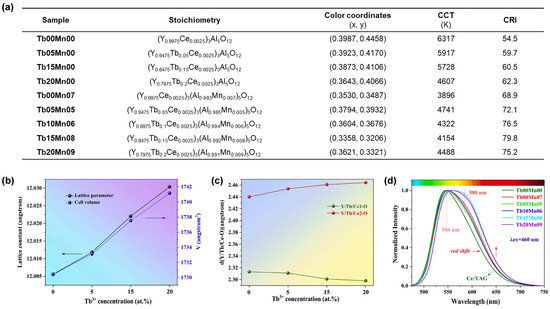
Figure 10.
(a) Ingredients, color coordinates, CCT, and CRI of the YTAMG:Ce3+ ceramics. (b) The variation of lattice parameters and volume of Tb00Mn00–Tb20Mn00 with Tb3+ concentration. (c) The Y/Tb/Ce1-O and Y/Tb/Ce2-O bond lengths of YTAMG:Ce3+ ceramics as a function of Tb3+ concentration. (d) Normalized PL spectra of all the YTAMG:Ce3+ ceramics (λex = 460 nm). Reprinted with permission from ref. [52]. Copyright 2021, Elsevier.
In another work presented by Duan et al. [66], Y3+ was not partially but instead completely replaced with Tb3+. They prepared a series of Tb2.997Al5−2xSixO12:0.003Ce3+,xMn2+ (S0–S4) phosphor ceramics with different contents of Mn2+-Si4+ (Figure 11a) via high-temperature solid-state reaction under oxygen. The synergistic effect of Tb3+ and Mn2+ resulted in orange-red emission in the case of S4, with an emission peak reaching 605 nm (Figure 11b). It is worth noting that wLED devices with high CRI (76.8–84.4) have been achieved by using a double-layer ceramic structure, where S0 is installed on the blue LED chip and S1–S4 are located on S0 respectively (Figure 11c).
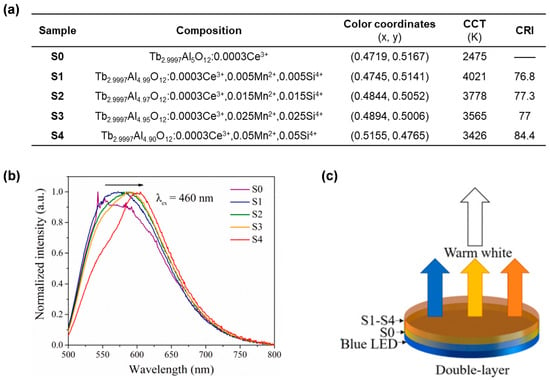
Figure 11.
(a) Compositions, color coordinates, CCT, and CRI of the S0–S4 ceramics. (b) Normalized PL spectra of S0–S4 (λex = 460 nm). (c) Schematic diagram of wLEDs based on the double-layer ceramic structure. Reprinted with permission from ref. [66]. Copyright 2021, Elsevier.
4.2. Co-Doping Mn2+ Ions into LuAG:Ce3+
Although modifying the YAG lattice with ions with larger ionic radii or ion pairs with longer bond lengths can redshift and/or widen the emission band of Ce3+, the thermal stability of the ceramic may be reduced if there is a large ion mismatch between the doped ions and the Y3+/Al3+ ions in the YAG lattice. In contrast, if the Y3+ ions in the YAG are completely replaced with Lu3+ ions with smaller ionic radius to form Lu3Al5O12 (LuAG), the thermal stability can be significantly improved [67]. In addition, Lu3−xAl5O12:xCe3+ (LuAG:Ce3+) exhibits greater absorption coefficient and higher quantum yield than YAG:Ce3+ [68,69,70,71]. Therefore, LuAG:Ce3+ ceramics have excellent heat-quenching performance and broad application prospects in automotive headlights, biomedical equipment, and projection systems. However, as LuAG:Ce3+ ceramics emit green light, the lack of red emission components in the PL spectra severely limits their practical application.
Since hexacoordinate Mn2+ ions display orange-red emission (4T1 → 6A1 transition of Mn2+) [72,73] and are feasible to be doped into LuAG:Ce3+ ceramics [70,74], Yang et al. prepared a series of LuAG:Ce3+,Mn2+ ceramics through a solid-state vacuum sintering technique [75]. The occupation of the octahedral Al3+ sites by Mn2+ ions enables orange light emission peaking at around 588 nm due to the strong crystal field (Figure 12a). As the content of Mn2+ increases, a small number of Mn2+ ions occupy the dodecahedron Lu3+ sites, resulting in far-red emission light peaking at 750 nm. In addition, due to the efficient energy transfer from Ce3+ to Mn2+ (5d1 → 4T1), with the increase of Mn2+ concentration, the emission intensity of the Ce3+ ions (5d1 → 4f, occupying the dodecahedral Lu3+ sites) at 505 nm decreases, while the emission intensity of Mn2+ at 588 nm increases (Figure 12a, inset). As a result, by controlling the doping concentration of Ce3+ and Mn2+-Si4+ (Si4+ ions as charge balancer to replace tetrahedral Al3+ sites), the emission spectrum of Lu2.98Al5−2xSixO12:0.02Ce3+,xMn2+ (x = 0–0.12) can be adjusted in the range of 500 to 800 nm (Figure 12a), almost covering visible light. Under ultraviolet irradiation, the samples emit color from green to yellow and orange (Figure 12b). In addition, the materials exhibit excellent thermal stability. When x = 0.01, the PL properties remain at 99% of the initial value at 425 K. When assembled with high-power blue LDs, the sample (x = 0.12) has a high CRI of 80.1 (Figure 12c), a correlation CCT of 3298 K, and an LE of 68 lm/W, showing good application potential in museum lighting.
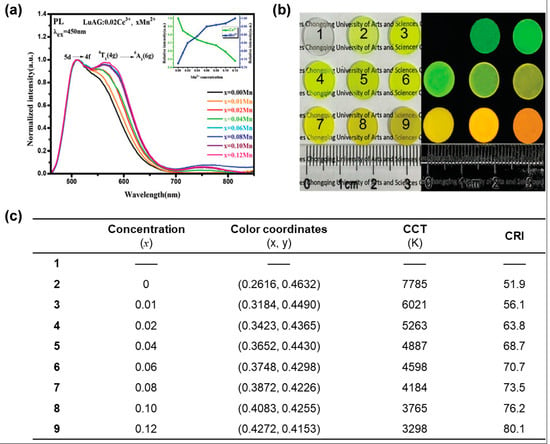
Figure 12.
(a) PL spectra (λex = 450 nm), (b) photos taken under natural light (left) and ultraviolet light (right), and (c) color coordinates, CCT, and CRI of the Lu2.98Al5−2xSixO12:0.02Ce3+,xMn2+ (x = 0–0.12) ceramics. Reprinted with permission from ref. [72]. Copyright 2020, The Royal Society of Chemistry.
To further improve the LE and CRI of the above-mentioned LuAG:Ce3+,Mn2+ ceramics, Ling et al. [76] also co-doped Ce3+ and Mn2+ into LuAG-based ceramics. A series of Lu2.998Al5−2ySiyO12:0.002Ce3+,yMn2+ (y = 0, 0.01, 0.03, 0.05, 0.07, 0.09) was synthesized via solid-state vacuum sintering, denoted as Ce02Mn0, Ce02Mn1, Ce02Mn3, Ce02Mn5, Ce02Mn7, and Ce02Mn9, respectively (Figure 13a). By carefully adjusting the occupied sites of Mn2+, the proportion of tricolor (orange, green, and blue) components can be changed, and the red emission centered at 590 nm and 750 nm can be effectively compensated. As a result, CRI achieved significant improvement. After assembling the LuAG:Ce3+,Mn2+ ceramics with blue LED, the variation of chromaticity parameters with Mn2+ doping concentration was systematically investigated (Figure 13b,c). When ceramic Ce02Mn7 was applied, pure white light with a CRI of up to 91.0 and an LE of up to 85.07 lm/W was obtained. Unfortunately, the reason for the improvements in CRI and LE of Lu2.998Al5−2ySiyO12:0.002Ce3+,yMn2+ (y = 0.07) compared with Lu2.98Al5−2xSixO12:0.02Ce3+,xMn2+ (x = 0.12) [72] was not elucidated.
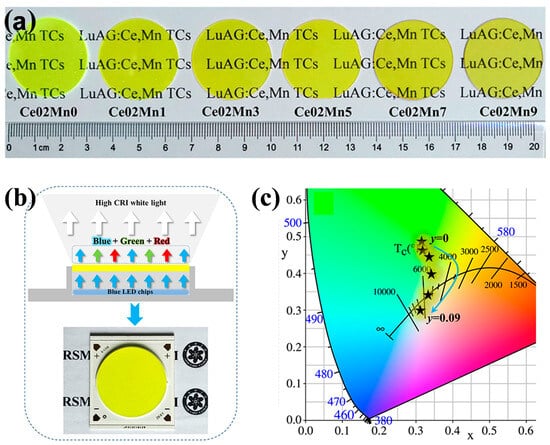
Figure 13.
(a) Photograph of as-prepared LuAG:Ce,Mn phosphor ceramics. (b) Schematic diagram of high-CRI wLED encapsulation and actual chip-on-board lighting source. (c) The CIE chromaticity coordination diagram of these fabricated LEDs. Reprinted with permission from ref. [76]. Copyright 2022, The American Ceramic Society.
4.3. Co-Doping Sm3+ and Mn2+ Ions into LuAG:Ce3+
Due to the 4G5/2 → 6HJ (J = 5/2 − 11/2) transitions of the 4f electrons of Sm3+ near-ultraviolet excitation, orange-red emission (>560 nm) may occur. However, Sm3+ is difficult to be excited by blue LD, limiting its applications in high-power wLD lighting. With this in mind, Sun et al. [77] doped Ce3+ and Sm3+ synchronously into LuAG to form highly transparent Lu2.98−xCe0.02SmxAl5O12 (LuAG:0.02Ce3+,xSm3+) (x = 0.001–0.01) ceramics through vacuum sintering. The XRD pattern, the lattice parameter of LuAG:0.02Ce3+,xSm3+ ceramics versus Sm3+ concentration, and the retrieved refinement of LuAG:0.02Ce3+,0.04Sm3+ ceramic have all evidenced the substitution of Ce3+ and Sm3+ for Lu3+ in the LuAG:Ce3+,Sm3+ ceramics. In addition, the spectral overlap between the PLE of LuAG:0.04Sm3+ and the PL of LuAG:0.02Ce3+ (Figure 14a), as well as the variation in emission intensity of Ce3+ (540 nm) and Sm3+ (618 nm) in (LuAG:0.02Ce3+,xSm3+) with Sm3+ concentration (Figure 14b), confirmed the effective energy transfer from Ce3+ to Sm3+. To overcome the narrow bandwidth of Sm3+, Mn2+/Si4+ were further incorporated, taking advantage of the orange emission of Mn2+ and charge compensation of Si4+. The as-prepared single-structured Lu3Mn0.04Al2.92Si0.04O12:0.02Ce3+,0.04Sm3+ (LuAG:0.02Ce3+,0.04Sm3+,0.04Mn2+) ceramics displayed characteristic emission of Ce3+ (530 nm, 5d1 → 4f transition), Sm3+ (618 nm, 4G5/2 → 6H7/2 f-f transition), and Mn2+ (590 nm, 4T1 → 6A1 d-d transition), resulting in a broad emission spectrum spanning from 500 nm to 750 nm (Figure 14c). The spectral overlap between the PLE of LuAG:0.04Sm3+ and the PL of LuAG:0.04Mn2+, and the lifetime-decay studies of LuAG:0.02Ce3+,0.04Sm3+ and LuAG:0.02Ce3+,0.04Sm3+,0.04Mn2+ suggest multiple energy-transfer processes of Ce3+ → Mn2+, Ce3+ → Sm3+, and Mn2+ → Sm3+ (Figure 14d). When the LuAG:0.02Ce3+,0.04Sm3+,0.04Mn2+ ceramic was coupled with a 450 nm blue LD, the resulting wLD exhibited a CRI of up to 78.5.

Figure 14.
(a) PLE spectra (λem = 618 nm) of LuAG:0.04Sm3+ ceramics (blue line) and PL spectrum (λex = 450 nm) of LuAG:0.02Ce3+ ceramics (red dashed line). (b) Relative intensity of Ce3+ (i) and Sm3+ (ii) of LuAG:0.02Ce3+,xSm3+ as a function of Sm3+ concentration (x). (c) PL spectra of LuAG:0.02Ce3+, LuAG:0.04Sm3+, LuAG:0.02Ce3+,0.04Sm3+, and LuAG:0.02Ce3+,0.04Sm3+,0.04Mn2+ ceramics. (d) Schematic energy level diagram of Ce3+, Sm3+, and Mn2+. Reprinted with permission from ref. [77]. Copyright 2021, The Royal Society of Chemistry.
5. Designing Composite Structural Ceramics
In addition to the above strategies, the design of composite structure ceramics, that is, the design of a double-layer converter with at least one layer of phosphor ceramic, can also broaden the emission spectrum, provided that the components of each layer and the structure between layers are subtly designed. In composite structural ceramics, the emission spectra range and color ratio of the two layers can be flexibly tuned, allowing improvement of the CRI. Moreover, they maintain the good thermal and mechanical performances of the parent ceramics. Therefore, the design of composite ceramics is a feasible way to achieve ceramics with high CRI values.
5.1. Combining Two Phosphor Ceramic Layers
To systematically investigate the influence of components and structure design on the properties of composite structural ceramics, Huang et al. [78] prepared double-layered YAG:Cr3+/YAG:Ce3+ (Cr01/Ce02) and YAG:Ce3+,Cr3+/YAG:Ce3+ (Ce01Cr01/Ce01) ceramics, as well as red-light-emitting Cr3+ co-doped YAG:Ce3+,Cr3+ (Ce02Cr01) single-layer ceramics (Figure 15a) through the vacuum sintering technique. As shown in Figure 15b, two characteristic emission bands centered at 540 nm and 687 nm appeared in the PL spectra for all ceramics containing Cr3+, which were attributed to the emission of Ce3+ and Cr3+, respectively. After the ceramics were packaged with 460 nm (2 W) blue LED chips, wLED devices were obtained and their electroluminescence spectra are shown in Figure 15c. In the yellow emission region (500–650 nm), the emission intensity of the single-layer Ce02Cr01 ceramic is significantly lower than that of the composite double-layer Cr01/Ce02 and Ce01Cr01/Ce01 ceramics. The reduced LE of the Ce02Cr01 ceramic can be ascribed to the energy consumption caused by the sensitization effect between Ce3+ ions and Cr3+ ions in this co-doping system. In the red emission region (650–750 nm), the emission intensity of Cr01/Ce02 is lower than that of Ce01Cr01/Ce01, even though they contain the same Cr3+ content and have the same double-layer structure. The results show that the combined strategy of “co-doping” and “composite double layer structure” is more effective to improve the excitation efficiency of Cr3+, because the emitted light from the lower layer (Ce01) and the local layer (Ce01Cr01) of the Ce3+ ion can both be absorbed by the Cr3+ ion. This is further verified by the shorter lifetime of Ce01Cr01/Ce01 (54.213 ns) than that of Cr01/Ce02 (66.349 ns); in other words, the energy transfer efficiency of Ce3+ → Cr3+ increased in Ce01Cr01/Ce01. The CRI values of all the ceramics containing Cr3+ were elevated compared with YAG:Ce3+ (Ce02Cr00), and both Ce02Cr01 and Ce01Cr01/Ce01 ceramics exhibited CRI values beyond 75. The lower CRI of Ce01Cr01/Ce01 (75.2) than Ce02Cr01 (82.7) is due to mismatched red–green–blue ratio.
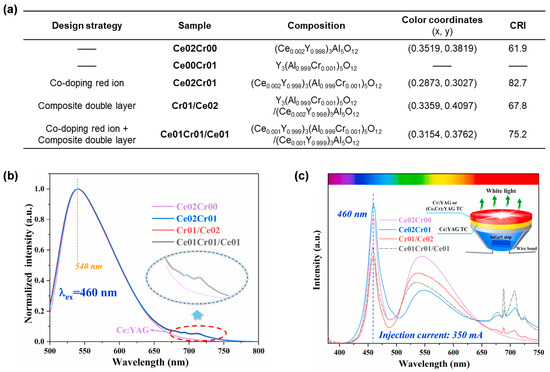
Figure 15.
(a) Ingredients, color coordinates, and CRI of the prepared ceramics with different chemical components. (b) Normalized PL spectra of the corresponding ceramics under excitation at 460 nm. (c) Schematic diagram of composite structure ceramic-based wLED device (inset) and electroluminescence spectra of the corresponding ceramics. Reprinted with permission from ref. [78]. Copyright 2021, Elsevier.
In another study reported by Lu et al. [60], the Al2O3-YAG eutectic was doped with Ce3+ and Cr3+ via a micro-pull-down method, respectively. When the Al2O3-YAG:Cr3+ was superimposed on the Al2O3-YAG:Ce3+ eutectic, the CRI of the Al2O3-YAG:Ce3+ and Al2O3-YAG:Cr3+ stacked LED reached 78.7.
Zhou et al. [79] also prepared LuAG:Ce3+,Cr3+ ceramics via solid-state sintering technique under vacuum condition. By combining YAG:Ce3+ ((Y0.995Ce0.005)3Al5O12) ceramic with LuAG:Ce3+,Cr3+ ((Lu0.009Ce0.001)3(Al0.996Cr0.004)5O12) ceramic, the ceramic-based wLED exhibited a CRI up to 88. Therefore, the “ceramic combination strategy” is highly promising for constructing high-quality wLEDs/wLDs.
5.2. Combining a Phosphor Ceramic Layer with a Free-Standing Phosphor Film
Because the combination of a color conversion layer with green emission and a color conversion layer with red emission can produce high CRI, Park et al. [80] selected a green-emitting LuAG:Ce3+ ceramic phosphor plate (CPP) and a red-emissive (Sr,Ca)AlSiN3:Eu2+-silicone resin film to form composite structural ceramics. The red film was designed and prepared as a free-standing film (f-film) because it can make the phosphor less affected by the high temperature of the LED chip. In addition, a two-dimensional (2D) SiNX photonic crystal layer (PCL) was introduced to improve the LE. All the fabricated wLEDs were color-converter-on-cup types, and different types of color converters, namely, the LuAG:Ce3+ CPP (c-flat CPP), the (Sr,Ca)AlSiN3:Eu2+ f-film, the 2D SiNX PCL-assisted CPP (SiNX-PCL CPP), and the SiNX-PCL CPP/f-film (Figure 16a), were attached to the top of the LED cups with silicone resin. The comparative influence of the f-films with different concentrations of (Sr,Ca)AlSiN3:Eu2+ on the EL properties of LEDs capped with c-flat CPP, SiNX-PCL CPP, and thickness-increased CPP/f-film (thick-flat CPP-0.15/f-film) was investigated. The LE of SiNX-PCL CPP/f-film-based LEDs were always higher than those of the c-flat CPP/f-film and thick-flat CPP-0.15/f-film-based LEDs (Figure 16b), indicating that the 2D SiNX PCL significantly increased the intensity of green emission. As shown in Figure 16c, the introduction of the f-films between the LuAG:Ce3+ CPP and the blue LED cup effectively improved the CRI. When the concentration of (Sr,Ca)AlSiN3:Eu2+ in the red film was over 7.5 wt%, the CRIs of both the SiNX-PCL CPP/f-film-based LED and the thick-flat CPP-0.15/f-film-based LED were over 90. Comprehensively, the SiNX-PCL CPP/f-film-based LED with a red phosphors concentration of 7.5 wt % exhibited an excellent CRI of 94 and an acceptable LE of 71.1 lm/W. Therefore, the combination of green-light-emitting phosphor ceramics, 2D PCL, and red phosphor f-film is effective to achieve high-power wLED with high CRI.

Figure 16.
(a) Schematic diagrams of 2D PCL-assisted CPP/free-standing red film phosphor (SiNX-PCL CPP/f-film)-based LED. (b) LE (lm/W), and (c) CRIs of the LuAG:Ce3+ CPP/free-standing red film phosphor (c-flat CPP/f-film)-based LED, the SiNX-PCL CPP/f-film -based LED, and the thickness-increased CPP (0.15 mm)/free-standing red film phosphor (thick-flat CPP-0.15/f-film)-based LED as functions of the red phosphor concentration at equal current (350 mA). Reprinted with permission from ref. [80]. Copyright 2015, American Chemical Society.
5.3. Coating a Phosphor/QDs Layer onto a Phosphor Ceramic Layer
To obtain high-quality white lighting with a high CRI, Zhou et al. [81] proposed a method to coat red-emitting SrAlSiN3:Eu2+ slurry composed of SrAlSiN3:Eu2+ phosphor and transparent organic ink on green-emitting Lu0.1Y2.84Al5O12:0.06Ce3+ (LuYAG:Ce3+) ceramic substrate. Since SrAlSiN3:Eu2+ slurries contain organic matter which suffers poor thermal conductivity, they firstly coated the slurry on the LuYAG:Ce3+ ceramic using a screen-printing technique, and then removed the organic matter by laser ablation drying. According to the EDS spectra of the red phosphor layer (Figure 17a), the C element in the red phosphor was greatly reduced after laser ablation, confirming the removal of organic components by the laser ablation. Under 460 nm excitation, the composite ceramic exhibited a wide emission band of 500–675 nm (Figure 17b), which is due to the 5d1 → 4f transitions of Ce3+ and Eu2+ ions, respectively. It is worth noting that the emission intensity of the composite ceramic before laser ablation is much lower than that after laser ablation, which can be explained by the difference in refractive index between the organic matter and the SrAlSiN3:Eu2+ fluorescent powder. In addition, the emission spectrum can be modulated by adjusting the number of screen prints (Figure 17c). When the composite ceramics were combined with blue LED chips, it was found that the color coordinates, the CRI, and the CCT of the wLEDs were influenced by both the package pattern (Figure 17d) and the thickness of the red-emitting film (Figure 17e). When the red phosphor film was facing away from the blue LED chip, the yellow-green radiation emitted by the LuYAG:Ce3+ ceramic layer under excitation of the LED chip was absorbed by the red phosphor, resulting in decreases in LE and CRI. When the red phosphor layer was facing the 1 W blue LED chip, a wLED with CRI of 89 was obtained with a printing number of 6.
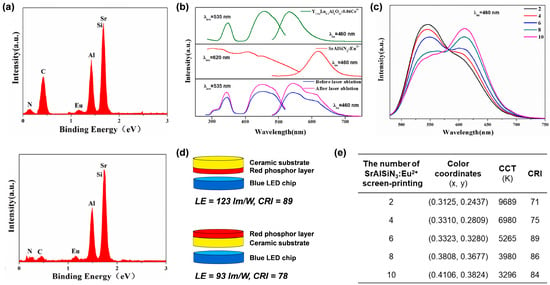
Figure 17.
(a) EDS spectra of red phosphor layer before (up) and after (below) laser ablation. (b) PLE and PL spectra of Lu0.1Y2.84Al5O12:0.06Ce3+ ceramic, SrAlSiN3:Eu2+ phosphor, and composite ceramics before and after laser ablation. (c) PL spectra of the composite ceramics with different times of SrAlSiN3:Eu2+ screen-printing under 460 nm excitation. (d) Schematic drawing of the packaged W-LEDs with the red phosphor layer facing (up) and facing away from (below) the blue LED chip. (e) Color coordinates, CCT, and CRI of the wLED packaged with 1 W blue LED chip and composite ceramics with different numbers of SrAlSiN3:Eu2+ screen printings. Reprinted with permission from ref. [81]. Copyright 2022, Elsevier.
In another work described by Zheng et al. [82], a tricolor converter system combined with a 405 nm near ultraviolet chip was employed. In traditional tricolor converter systems, the nitride/fluoride red phosphors always show low thermal stability under high-power excitation and exhibit broad emission bands exceeding 650 nm that are difficult to perceived with human eyes, leading to a decrease in LE. To address the issue, the authors used vacuum sintering to prepare red-color-converter (SmxY1−x)3Al5O12 (x = 0.005, 0.01, 0.02, and 0.03) (YAG:Sm3+) ceramics with a narrow emission band and excellent thermal conductivity. A double-layer tricolor converter system was fabricated by coating a phosphor in silicone (PIS) film consisting of green-emitting (Sr,Ba)2SiO4:Eu2+ phosphor powders, blue-emitting BaMgAl10O17:Eu2+ phosphor powders, and organic silicon resin on the red-emitting YAG:Sm3+ ceramic. The blue/green-emitting PIS (PIS(GB))-coated YAG:Sm3+ samples were then hardened at 140 °C for 4 h to form the double-layer YAG(R)-PIS(GB) converter (Figure 18a,b). The cross-sectional SEM image (Figure 18c) shows that the PIS(GB) film is tightly bonded to the YAG:Sm3+ ceramic, effectively avoiding light-transmission loss and reducing interfacial thermal resistance. By modulating the concentration of Sm3+ in YAG:Sm3+ ceramics and fixing the thickness of the PIS(GB) film to 100 μm, the optical properties of the YAG(R)-PIS(GB) converter were optimized, and a CRI of 92.6 was achieved when x = 0.01 (Figure 18d,e). Compared with single-layer PIS(RGB) composed of red-emitting YAG:Sm3+, green-emitting (Sr,Ba)2SiO4:Eu2+ and blue-emitting BaMgAl10O17:Eu2+ phosphor powders, and organic silicon resin (Figure 18a), the YAG(R)-PIS(GB) converter exhibited higher heat transfer efficiency and avoided the blue emission from being self-absorbed by the red converter. Therefore, such a double-layer tricolor converter has broad application prospects in high-power lighting devices.
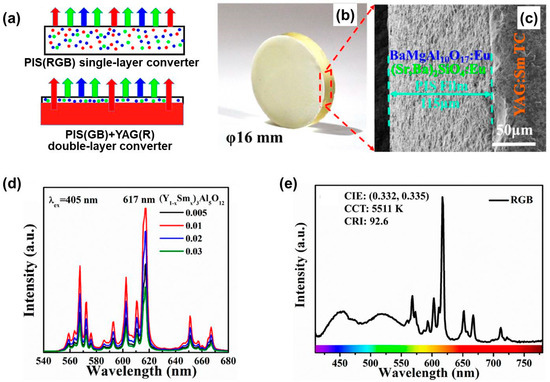
Figure 18.
(a) Schematic diagrams of the single-layer converter (above) and double-layer converter (below). (b) Photograph and (c) cross-sectional SEM image of the double-layer white-light converter. (d) PL spectra of the (SmxY1−x)3Al5O12 (x = 0.005, 0.01, 0.02, and 0.03) ceramics under 405 nm excitation wavelength. (e) PL spectrum of the LED-driven tricolor converter under 405 nm excitation. Reprinted with permission from ref. [82]. Copyright 2019, American Chemical Society.
Xu et al. [83] coated a red-emitting quantum dot (QD) (λem = 634 nm) layer (CaSiAlN3:Eu2+) instead of red-emitting PIS on an Al2O3-YAG:Ce3+ ceramic plate to construct composite structural ceramics. The red-emitting QD was employed to overcome the luminescence saturation behavior of red-emitting phosphors at low power densities. Due to the excellent thermal conductivity of CPP, the coating of QD onto CPP can reduce the thermal erosion of the QD layer caused by laser irradiation. Under the irradiation of a blue laser (445 nm, 5 W), the surface temperature of the QD layer was as low as 68 °C, and no luminescence saturation occurred. When the CPP-QD was combined with a blue LD, the wLD device exhibited a CRI of up to 80, indicating the feasibility of applying CPP-QD in high-power wLD lighting.
6. Conclusions and Perspectives
In this review, we have provided a comprehensive overview of the preparation strategies for TPCs for the construction of high-power and high color rendering wLED/wLD lighting sources. These strategies can be primarily classified into four categories: host regulation, red-emitter doping, host regulation/red-emitter doping combination, and composite structure design. All the lighting systems exhibit high CRI (>75) with high stability and long lifespan. Additionally, their design principles, PL characteristics, and mechanisms for PL modulation were thoroughly discussed. This review addresses the previous lack of a summary of this research topic.
At present, the results of research in this area are still limited. On the one hand, we believe that the appropriate combination of the strategies summarized in this review can further improve device performance. On the other hand, although high-power and high-CRI wLED/wLD devices based on various TPCs have been successfully built, achieving the delicate balance between high chrominance and high LE remains a huge challenge. We believe that improving CRI while maintaining the high LE of wLED/wLD is a key goal for the next generation of high-power lighting. Moreover, in practical applications, in addition to LE and CRI, some other factors need to be considered. For instance, in multi-phase ceramics, taking Al2O3-YAG:Ce3+ as an example, it is usually difficult to achieve uniform distribution, which has a negative impact on the heat dissipation and uniformity of the luminescent centers of the ceramics. To address the issue, “unique” microstructures of these phosphor converters were developed to control light scattering and achieve color uniformity [84]. Homogeneous initial powder materials were obtained by regulating the excess of Al3+ of YAG:Ce3+ in the process of co-precipitation, which provided a possible way to optimize the composition uniformity of Al2O3-YAG:Ce3+ TPCs [85]. Many of these techniques to achieve high-quality TPCs are yet to be explored.
Author Contributions
Investigation, B.D. and F.L.; Writing—Original Draft, B.D. and F.L.; Visualization, W.L., L.Z. and P.C.; Supervision, Funding Acquisition, Writing—Review & Editing, F.L. All authors have read and agreed to the published version of the manuscript.
Funding
This work was supported by the National Natural Science Foundation of the People’s Republic of China (Grant No. 22101027) and Shaanxi Province Technical Innovation Guidance Special Fund (Grant No. S2022-YD-CGZH-0036).
Conflicts of Interest
The authors declare no conflicts of interest.
References
- Bando, K.; Sakano, K.; Noguchi, Y.; Shimizu, Y. Development of high-bright and pure-white LED lamps. J. Light Vis. Environ. 1998, 22, 2–5. [Google Scholar] [CrossRef]
- Nakamura, S.; Fasol, G. The Blue Laser Diode; Springer: Berlin/Heidelberg, Germany, 1997. [Google Scholar]
- Tsao, J.Y.; Crawford, M.H.; Coltrin, M.E.; Fischer, A.J.; Koleske, D.D.; Subramania, G.S.; Wang, G.T.; Wierer, J.J.; Karlicek, R.F., Jr. Toward smart and ultra-efficient solid-state lighting. Adv. Opt. Mater. 2014, 2, 809–836. [Google Scholar] [CrossRef]
- Pulli, T.; Dönsberg, T.; Poikonen, T.; Manoocheri, F.; Kärhä, P.; Ikonen, E. Advantages of white LED lamps and new detector technology in photometry. Light Sci. Appl. 2015, 4, e332. [Google Scholar] [CrossRef]
- Zhang, X.; Huang, L.; Pan, F.; Wu, M.; Wang, J.; Chen, Y.; Su, Q. Highly thermally stable single-component white-emitting silicate glass for organic-resin-free white-light-emitting diodes. ACS Appl. Mater. Interfaces 2014, 6, 2709–2717. [Google Scholar] [CrossRef]
- Kim, J.-S.; Yang, S.; Bae, B.-S. Thermally stable transparent sol−gel based siloxane hybrid material with high refractive index for light emitting diode (LED) encapsulation. Chem. Mater. 2010, 22, 3549–3555. [Google Scholar] [CrossRef]
- Ishikawa, T.; Sakata, S.-i.; Mitani, A. Durable, ultraluminous structure for incandescent, high-power white-LED. Int. J. Appl. Ceram. Technol. 2006, 3, 144–149. [Google Scholar] [CrossRef]
- Xu, J.; Liu, B.; Liu, Z.; Gong, Y.; Hu, B.; Wang, J.; Li, H.; Wang, X.; Du, B. Design of laser-driven SiO2-YAG:Ce composite thick film: Facile synthesis, robust thermal performance, and application in solid-state laser lighting. Opt. Mater. 2018, 75, 508–512. [Google Scholar] [CrossRef]
- Cozzan, C.; Lheureux, G.; O’Dea, N.; Levin, E.E.; Graser, J.; Sparks, T.D.; Nakamura, S.; DenBaars, S.P.; Weisbuch, C.; Seshadri, R. Stable, heat-conducting phosphor composites for high-power laser lighting. ACS Appl. Mater. Interfaces 2018, 10, 5673–5681. [Google Scholar] [CrossRef] [PubMed]
- Lai, C.-F.; Li, J.-S.; Shen, C.-W. High-efficiency robust free-standing composited phosphor films with 2D and 3D nanostructures for high-power remote white LEDs. ACS Appl. Mater. Interfaces 2017, 9, 4851–4859. [Google Scholar] [CrossRef]
- Zhao, Y.; Xu, H.; Zhang, X.; Zhu, G.; Yan, D.; Yu, A. Facile synthesis of YAG:Ce3+ thick films for phosphor converted white light emitting diodes. J. Eur. Ceram. Soc. 2015, 35, 3761–3764. [Google Scholar] [CrossRef]
- Revaux, A.; Dantelle, G.; George, N.; Seshadri, R.; Gacoin, T.; Boilot, J.-P. A protected annealing strategy to enhanced light emission and photostability of YAG:Ce nanoparticle-based films. Nanoscale 2011, 3, 2015–2022. [Google Scholar] [CrossRef]
- Lee, J.S.; Arunkumar, P.; Kim, S.; Lee, I.J.; Lee, H.; Im, W.B. Smart design to resolve spectral overlapping of phosphor-in-glass for high-powered remote-type white light-emitting devices. Opt. Lett. 2014, 39, 762–765. [Google Scholar] [CrossRef] [PubMed]
- Chen, D.; Xiang, W.; Liang, X.; Zhong, J.; Yu, H.; Ding, M.; Lu, H.; Ji, Z. Advances in transparent glass–ceramic phosphors for white light-emitting diodes—A review. J. Eur. Ceram. Soc. 2015, 35, 859–869. [Google Scholar] [CrossRef]
- Kim, S.; Park, H.-A.; Im, W.B.; Heo, J.; Choi, J.-Y.; Chung, W.J. A low sintering temperature glass based on SiO2–P2O5–ZnO–B2O3–R2O system for white LEDs with high color rendering index. J. Am. Ceram. Soc. 2017, 100, 5186–5192. [Google Scholar] [CrossRef]
- Yu, J.; Si, S.; Liu, Y.; Zhang, X.; Cho, Y.; Tian, Z.; Xie, R.; Zhang, H.; Li, Y.; Wang, J. High-power laser-driven phosphor-in-glass for excellently high conversion efficiency white light generation for special illumination or display backlighting. J. Mater. Chem. C 2018, 6, 8212–8218. [Google Scholar] [CrossRef]
- Kim, Y.H.; Viswanath, N.S.M.; Unithrattil, S.; Kim, H.J.; Im, W.B. Review—Phosphor plates for high-power LED applications: Challenges and opportunities toward perfect lighting. ECS J. Solid State Sci. Technol. 2018, 7, R3134. [Google Scholar] [CrossRef]
- Huang, M.-H.; Zhu, Q.-Q.; Li, S.; Zhai, Y.; Zhang, H.; Wang, L.; Xie, R.-J. Thermally robust Al2O3-La3Si6N11:Ce3+ composite phosphor-in-glass (PiG) films for high-power and brightness laser-driven lighting. J. Mater. Chem. C 2023, 11, 488–496. [Google Scholar] [CrossRef]
- Wang, L.; Wei, R.; Zheng, P.; You, S.; Zhou, T.-L.; Yi, W.; Takeda, T.; Hirosaki, N.; Xie, R.-J. Realizing high-brightness and ultra-wide-color-gamut laser-driven backlighting by using laminated phosphor-in-glass (PiG) films. J. Mater. Chem. C 2020, 8, 1746–1754. [Google Scholar] [CrossRef]
- You, S.; Li, S.; Zheng, P.; Zhou, T.; Wang, L.; Liu, L.; Horisaki, N.; Xu, F.; Xie, R.-J. A thermally robust La3Si6N11:Ce-in-glass film for high-brightness blue-laser-driven solid state lighting. Laser Photonics Rev. 2019, 13, 1800216. [Google Scholar] [CrossRef]
- Wei, R.; Wang, L.; Zheng, P.; Zeng, H.; Pan, G.; Zhang, H.; Liang, P.; Zhou, T.; Xie, R. On the luminance saturation of phosphor-in-glass (PiG) films for blue-laser-driven white lighting: Effects of the phosphor content and the film thickness. J. Eur. Ceram. Soc. 2019, 39, 1909–1917. [Google Scholar] [CrossRef]
- Chung, W.J.; Nam, Y.H. Review—A review on phosphor in glass as a high power LED color converter. ECS J. Solid State Sci. Technol. 2020, 9, 016010. [Google Scholar] [CrossRef]
- Fujita, S.; Yoshihara, S.; Sakamoto, A.; Yamamoto, S.; Tanabe, S. YAG glass-ceramic phosphor for white LED (I): Background and development. In Proceedings of the Fifth International Conference on Solid State Lighting, San Diego, CA, USA, 14 September 2005; SPIE: Bellingham, WA, USA; Volume 5941. [Google Scholar]
- Tanabe, S.; Fujita, S.; Yoshihara, S.; Sakamoto, A.; Yamamoto, S. YAG glass-ceramic phosphor for white LED (II): Luminescence characteristics. In Proceedings of the Fifth International Conference on Solid State Lighting, San Diego, CA, USA, 13 September 2005; SPIE: Bellingham, WA, USA; Volume 5941. [Google Scholar]
- Chen, D.; Xu, W.; Zhou, Y.; Zhong, J.; Li, S. Color tunable dual-phase transparent glass ceramics for warm white light-emitting diodes. J. Mater. Chem. C 2017, 5, 738–746. [Google Scholar] [CrossRef]
- Lin, H.; Hu, T.; Cheng, Y.; Chen, M.; Wang, Y. Glass Ceramic Phosphors: Towards Long-Lifetime High-Power White Light-Emitting-Diode Applications–A Review. Laser Photonics Rev. 2018, 12, 1700344. [Google Scholar] [CrossRef]
- He, M.; Jia, J.; Zhao, J.; Qiao, X.; Du, J.; Fan, X. Glass-ceramic phosphors for solid state lighting: A review. Ceram. Int. 2021, 47, 2963–2980. [Google Scholar] [CrossRef]
- Latynina, A.; Watanabe, M.; Inomata, D.; Aoki, K.; Sugahara, Y.; García Víllora, E.; Shimamura, K. Properties of czochralski grown Ce,Gd:Y3Al5O12 single crystal for white light-emitting diode. J. Alloys Compd. 2013, 553, 89–92. [Google Scholar] [CrossRef]
- Gu, G.; Xiang, W.; Yang, C.; Liang, X. Synthesis and luminescence properties of a H2 annealed Mn-doped Y3Al5O12:Ce3+ single crystal for WLEDs. CrystEngComm 2015, 17, 4554–4561. [Google Scholar] [CrossRef]
- Yang, C.; Gu, G.; Zhao, X.; Liang, X.; Xiang, W. The growth and luminescence properties of Y3Al5O12:Ce3+ single crystal by doping Gd3+ for W-LEDs. Mater. Lett. 2016, 170, 58–61. [Google Scholar] [CrossRef]
- Kang, T.W.; Park, K.W.; Ryu, J.H.; Lim, S.G.; Yu, Y.M.; Kim, J.S. Strong thermal stability of Lu3Al5O12:Ce3+ single crystal phosphor for laser lighting. J. Lumin. 2017, 191, 35–39. [Google Scholar] [CrossRef]
- Balci, M.H.; Chen, F.; Cunbul, A.B.; Svensen, Ø.; Akram, M.N.; Chen, X. Comparative study of blue laser diode driven cerium-doped single crystal phosphors in application of high-power lighting and display technologies. Opt. Rev. 2018, 25, 166–174. [Google Scholar] [CrossRef]
- Xu, J.; Thorseth, A.; Xu, C.; Krasnoshchoka, A.; Rosendal, M.; Dam-Hansen, C.; Du, B.; Gong, Y.; Jensen, O.B. Investigation of laser-induced luminescence saturation in a single-crystal YAG:Ce phosphor: Towards unique architecture, high saturation threshold, and high-brightness laser-driven white lighting. J. Lumin. 2019, 212, 279–285. [Google Scholar] [CrossRef]
- Nishiura, S.; Tanabe, S.; Fujioka, K.; Fujimoto, Y.; Nakatsuka, M. Preparation and optical properties of transparent Ce:YAG ceramics for high power white LED. IOP Conf. Ser. Mater. Sci. Eng. 2009, 1, 012031. [Google Scholar] [CrossRef]
- Nishiura, S.; Tanabe, S.; Fujioka, K.; Fujimoto, Y. Properties of transparent Ce:YAG ceramic phosphors for white LED. Opt. Mater. 2011, 33, 688–691. [Google Scholar] [CrossRef]
- Sun, B.; Zhang, L.; Huang, G.; Li, Y.; Zhou, T.; Kang, J.; Zhang, L.; Ma, Y.; Yao, Q.; A Selim, F.; et al. Fabrication, optical and luminescence properties of low pressure injection molded YAG:Ce tubular ceramics for outdoor lighting. J. Eur. Ceram. Soc. 2021, 41, 1564–1571. [Google Scholar] [CrossRef]
- Peng, X.; Li, S.; Liu, Z.; Zhang, B.; Peng, Y.; Yu, D.; Tian, R.; Yao, X.; Huang, Z.; Liu, X.; et al. Highly thermal conductive red-emitting AlN-CaAlSiN3:Eu2+ composite phosphor ceramics for high-power laser-driven lighting. J. Eur. Ceram. Soc. 2021, 41, 5650–5657. [Google Scholar] [CrossRef]
- Li, S.; Zhu, Q.; Tang, D.; Liu, X.; Ouyang, G.; Cao, L.; Hirosaki, N.; Nishimura, T.; Huang, Z.; Xie, R.-J. Al2O3–YAG:Ce composite phosphor ceramic: A thermally robust and efficient color converter for solid state laser lighting. J. Mater. Chem. C 2016, 4, 8648–8654. [Google Scholar] [CrossRef]
- Wei, N.; Lu, T.; Lu, T.; Li, F.; Zhang, W.; Zhang, W.; Zhang, W.; Ma, B.; Lu, Z.; Qi, J. Transparent Ce:Y3Al5O12 ceramic phosphors for white light-emitting diodes. Appl. Phys. Lett. 2012, 101, 061902. [Google Scholar] [CrossRef]
- Liu, G.H.; Zhou, Z.Z.; Shi, Y.; Liu, Q.; Wan, J.Q.; Pan, Y.B. Ce:YAG transparent ceramics for applications of high power LEDs: Thickness effects and high temperature performance. Mater. Lett. 2015, 139, 480–482. [Google Scholar] [CrossRef]
- Hu, S.; Lu, C.; Zhou, G.; Liu, X.; Qin, X.; Liu, G.; Wang, S.; Xu, Z. Transparent YAG:Ce ceramics for WLEDs with high CRI: Ce3+ concentration and sample thickness effects. Ceram. Int. 2016, 42, 6935–6941. [Google Scholar] [CrossRef]
- Bechtel, H.; Schmidt, P.; Busselt, W.; Schreinemacher, B. Lumiramic: A new phosphor technology for high performance solid state light sources. In Proceedings of the Eighth International Conference on Solid State Lighting, San Diego, CA, USA, 2 September 2008; SPIE: Bellingham, WA, USA, 2008; Volume 7058. [Google Scholar]
- Ma, X.; Li, X.; Li, J.; Genevois, C.; Ma, B.; Etienne, A.; Wan, C.; Véron, E.; Peng, Z.; Allix, M. Pressureless glass crystallization of transparent yttrium aluminum garnet-based nanoceramics. Nat. Commun. 2018, 9, 1175. [Google Scholar] [CrossRef]
- Wierer, J.J., Jr.; Tsao, J.Y.; Sizov, D.S. Comparison between blue lasers and light-emitting diodes for future solid-state lighting. Laser Photonics Rev. 2013, 7, 963–993. [Google Scholar] [CrossRef]
- Sun, B.; Jiang, X.; Yung, K.-C.; Fan, J.; Pecht, M.G. A review of prognostic techniques for high-power white LEDs. IEEE T. Power Electr. 2017, 32, 6338–6362. [Google Scholar] [CrossRef]
- Ma, Y.; Luo, X. Packaging for laser-based white lighting: Status and perspectives. J. Electron. Packag. 2020, 142, 010801. [Google Scholar] [CrossRef]
- Shang, M.; Fan, J.; Lian, H.; Zhang, Y.; Geng, D.; Lin, J. A double substitution of Mg2+–Si4+/Ge4+ for Al(1)3+–Al(2)3+ in Ce3+-doped garnet phosphor for white LEDs. Inorg. Chem. 2014, 53, 7748–7755. [Google Scholar] [CrossRef] [PubMed]
- Robertson, J.M.; van Tol, M.W.; Smits, W.H.; Heynen, J.P.H. Colourshift of the Ce3+ emission in monocrystalline epitaxially grown garnet layers. Philips J. Res. 1981, 36, 15–30. [Google Scholar]
- Du, Q.; Feng, S.; Qin, H.; Hua, H.; Ding, H.; Jia, L.; Zhang, Z.; Jiang, J.; Jiang, H. Massive red-shifting of Ce3+ emission by Mg2+ and Si4+ doping of YAG:Ce transparent ceramic phosphors. J. Mater. Chem. C 2018, 6, 12200–12205. [Google Scholar] [CrossRef]
- Ding, H.; Hu, P.; Liu, Z.; Sun, P.; Liu, Y.; Luo, Z.; Chao, K.; Jiang, H.; Jiang, J. Effect of Ca2+-Si4+ on Y3Al5O12:Ce ceramic phosphors for white laser-diodes lighting. Appl. Phys. Lett. 2021, 118, 211902. [Google Scholar] [CrossRef]
- Kosyanov, D.Y.; Liu, X.; Vornovskikh, A.A.; Kosianova, A.A.; Zakharenko, A.M.; Zavjalov, A.P.; Shichalin, O.O.; Mayorov, V.Y.; Kuryavyi, V.G.; Qian, X.; et al. Al2O3–Ce:YAG and Al2O3–Ce:(Y,Gd)AG composite ceramics for high brightness lighting: Effect of microstructure. Mater. Charact. 2021, 172, 110883. [Google Scholar] [CrossRef]
- Ma, Y.; Zhang, L.; Zhou, T.; Sun, B.; Hou, C.; Yang, S.; Huang, J.; Wang, R.; Selim, F.A.; Wang, Z.; et al. Dual effect synergistically triggered Ce:(Y,Tb)3(Al,Mn)5O12 transparent ceramics enabling a high color-rendering index and excellent thermal stability for white LEDs. J. Eur. Ceram. Soc. 2021, 41, 2834–2846. [Google Scholar] [CrossRef]
- Meng, Q.; Zhu, Q.; Li, X.; Sun, X.; Li, J.-G. New Mg2+/Ge4+-stabilized Gd3MgxGexAl5–2xO12:Ce garnet phosphor with orange-yellow emission for warm-white LEDs (x = 2.0–2.5). Inorg. Chem. 2021, 60, 9773–9784. [Google Scholar] [CrossRef]
- Nishiura, S.; Tanabe, S.; Fujioka, K.; Fujimoto, Y. Preparation of transparent Ce3+:GdYAG ceramics phosphors for white LED. IOP Conf. Ser. Mater. Sci. Eng. 2011, 18, 102005. [Google Scholar] [CrossRef]
- Chen, J.; Deng, Z.; Liu, Z.; Lin, Y.; Lan, H.; Chen, D.; Fei, B.; Wang, C.; Wang, F.; Hu, Q.; et al. Optical enhancement brought by doping Gd3+ ions into Ce: YAG ceramics for indoor white light-emitting diodes. Opt. Express 2015, 23, A292–A298. [Google Scholar] [CrossRef]
- Dorenbos, P. Electronic structure and optical properties of the lanthanide activated RE3(Al1−xGax)5O12 (RE=Gd, Y, Lu) garnet compounds. J. Lumin. 2013, 134, 310–318. [Google Scholar] [CrossRef]
- Liu, S.; Sun, P.; Liu, Y.; Zhou, T.; Li, S.; Xie, R.-J.; Xu, X.; Dong, R.; Jiang, J.; Jiang, H. Warm white light with a high color-rendering index from a single Gd3Al4GaO12:Ce3+ transparent ceramic for high-power LEDs and LDs. ACS Appl. Mater. Interfaces 2019, 11, 2130–2139. [Google Scholar] [CrossRef] [PubMed]
- Sun, P.; Hu, P.; Liu, Y.; Liu, S.; Dong, R.; Jiang, J.; Jiang, H. Broadband emissions from Lu2Mg2Al2Si2O12:Ce3+ plate ceramic phosphors enable a high color-rendering index for laser-driven lighting. J. Mater. Chem. C 2020, 8, 1405–1412. [Google Scholar] [CrossRef]
- Zhou, Y.; Zhuang, W.; Hu, Y.; Liu, R.; Jiang, Z.; Liu, Y.; Li, Y.; Zheng, Y.; Chen, L.; Zhong, J. A broad-band orange-yellow-emitting Lu2Mg2Al2Si2O12:Ce3+ phosphor for application in warm white light-emitting diodes. RSC Adv. 2017, 7, 46713–46720. [Google Scholar] [CrossRef]
- Lu, H.; Song, Q.; Xu, X.; Liu, P.; Liu, J.; Xu, J.; Tao, X.; Wang, J.; Bian, K.; Lu, W.; et al. Improving the CRI of Al2O3-YAG:Ce eutectic for high-power white LEDs applications: Energy-transfer and co-luminescence. Opt. Mater. 2021, 121, 111415. [Google Scholar] [CrossRef]
- Liu, Y.; Su, H.; Lu, Z.; Shen, Z.; Guo, Y.; Zhao, D.; Li, S.; Zhang, J.; Liu, L.; Fu, H. Energy transfer and thermal stability enhancement in Ce/Cr co-doped Al2O3/YAG eutectic phosphor ceramics for broadband red-emission. Ceram. Int. 2022, 48, 23598–23608. [Google Scholar] [CrossRef]
- Li, X.; Zhang, C.; Chen, J.; Liu, Q.; Bai, Z.; Liu, X.; Mi, X. Cr3+ ions improving the spectral properties of YAG:Ce3+ luminescent ceramics for white LD lighting. Ceram. Int. 2023, 49, 5489–5495. [Google Scholar] [CrossRef]
- Ao, G.; Tang, Y.; Yi, X.; Tian, Y.; Chen, J.; Hao, D.; Lin, Y.; Zhou, S. Red emission generation in Ce3+/Mn2+ co-doping Y3Al5O12 phosphor ceramics for warm white lighting emitting diodes. J. Alloys Compd. 2019, 798, 695–699. [Google Scholar] [CrossRef]
- Feng, S.; Qin, H.; Wu, G.; Jiang, H.; Zhao, J.; Liu, Y.; Luo, Z.; Qiao, J.; Jiang, J. Spectrum regulation of YAG:Ce transparent ceramics with Pr, Cr doping for white light emitting diodes application. J. Eur. Ceram. Soc. 2017, 37, 3403–3409. [Google Scholar] [CrossRef]
- Ma, Y.; Zhang, L.; Zhou, T.; Sun, B.; Wang, Y.; Kang, J.; Gao, P.; Huang, J.; Selim, F.A.; Wong, C.; et al. High recorded color rendering index in single Ce,(Pr,Mn):YAG transparent ceramics for high-power white LEDs/LDs. J. Mater. Chem. C 2020, 8, 4329–4337. [Google Scholar] [CrossRef]
- Duan, Y.; Zhao, C.; Lin, H.; Hong, R.; Tao, C.; Han, Z.; Zhang, D.; Zhou, S. Photoluminescence properties of Tb3Al5O12:Ce3+,Mn2+ phosphor ceramics for high color rendering index warm white LEDs. Opt. Mater. 2021, 111, 110670. [Google Scholar] [CrossRef]
- Xu, Y.; Li, S.; Zheng, P.; Wang, L.; You, S.; Takeda, T.; Hirosaki, N.; Xie, R.-J. A search for extra-high brightness laser-driven color converters by investigating thermally-induced luminance saturation. J. Mater. Chem. C 2019, 7, 11449–11456. [Google Scholar] [CrossRef]
- Li, H.-L.; Liu, X.-J.; Huang, L.-P. Fabrication of transparent cerium-doped lutetium aluminum garnet (LuAG:Ce) ceramics by a solid-state reaction method. J. Am. Ceram. Soc. 2005, 88, 3226–3228. [Google Scholar] [CrossRef]
- Praveena, R.; Shi, L.; Jang, K.H.; Venkatramu, V.; Jayasankar, C.K.; Seo, H.J. Sol–gel synthesis and thermal stability of luminescence of Lu3Al5O12:Ce3+ nano-garnet. J. Alloys Compd. 2011, 509, 859–863. [Google Scholar] [CrossRef]
- Xu, J.; Shi, Y.; Xie, J.; Lei, F. Fabrication, microstructure, and luminescent properties of Ce3+-Doped Lu3Al5O12 (Ce:LuAG) transparent ceramics by low-temperature vacuum sintering. J. Am. Ceram. Soc. 2013, 96, 1930–1936. [Google Scholar] [CrossRef]
- Xu, J.; Fan, L.; Shi, Y.; Li, J.; Xie, J.; Lei, F. Effects of Ce3+ doping concentrations on microstructure and luminescent properties of Ce3+:Lu3Al5O12 (Ce:LuAG) transparent ceramics. Opt. Mater. 2014, 36, 1954–1958. [Google Scholar] [CrossRef]
- Guo, N.; Huang, Y.; You, H.; Yang, M.; Song, Y.; Liu, K.; Zheng, Y. Ca9Lu(PO4)7:Eu2+,Mn2+: A potential single-phased white-light-emitting phosphor suitable for white-light-emitting diodes. Inorg. Chem. 2010, 49, 10907–10913. [Google Scholar] [CrossRef]
- Huang, C.-H.; Chen, T.-M. A novel single-composition trichromatic white-light Ca3Y(GaO)3(BO3)4:Ce3+,Mn2+,Tb3+ phosphor for UV-light emitting diodes. J. Phys. Chem. C 2011, 115, 2349–2355. [Google Scholar] [CrossRef]
- Zhang, Y.; Hu, S.; Wang, Z.; Zhou, G.; Wang, S. Pore-existing Lu3Al5O12:Ce ceramic phosphor: An efficient green color converter for laser light source. J. Lumin. 2018, 197, 331–334. [Google Scholar] [CrossRef]
- Yang, J.; Han, T.; Cao, Y.; Lang, T.; Fang, S.; Cao, S.; Peng, L.; Liu, B.; Tian, Z.; Gao, W. Photoluminescent transparent ceramics with an adjustable spectrum for high-color rendering laser lighting. J. Mater. Chem. C 2020, 8, 16483–16488. [Google Scholar] [CrossRef]
- Ling, J.; Zhang, Y.; Yang, J.; Li, Y.; Xu, W.; Zhou, Y.; Hong, M. A single-structured LuAG:Ce,Mn phosphor ceramics with high CRI for high-power white LEDs. J. Am. Ceram. Soc. 2022, 105, 5738–5750. [Google Scholar] [CrossRef]
- Sun, B.; Jiang, B.; Zhang, L. Samarium and manganese incorporation to improve color rendering of LuAG:Ce3+ phosphor ceramics for laser-driven lighting: A Color-tunable and energy transfer study. J. Mater. Chem. C 2021, 9, 16468–16476. [Google Scholar] [CrossRef]
- Huang, J.; Ni, Y.; Ma, Y.; Li, Y.; Sun, Z.; Zhu, X.; Wang, R.; Li, T.; Xi, X.; Huang, G.; et al. Composite structure Cr:YAG/Ce:YAG and (Ce,Cr):YAG/Ce:YAG transparent ceramics with high color rendering index for white LEDs/LDs. Ceram. Int. 2021, 47, 11415–11422. [Google Scholar] [CrossRef]
- Zhou, T.; Hou, C.; Zhang, L.; Ma, Y.; Kang, J.; Li, T.; Wang, R.; Huang, J.; Li, J.; Ren, H.; et al. Efficient spectral regulation in Ce:Lu3(Al,Cr)5O12 and Ce:Lu3(Al,Cr)5O12/Ce:Y3Al5O12 transparent ceramics with high color rendering index for high-power white LEDs/LDs. J. Adv. Ceram. 2021, 10, 1107–1118. [Google Scholar] [CrossRef]
- Park, H.K.; Oh, J.H.; Kang, H.; Zhang, J.; Do, Y.R. Hybrid 2D photonic crystal-assisted Lu3Al5O12:Ce ceramic-plate phosphor and free-standing red film phosphor for white LEDs with high color-rendering index. ACS Appl. Mater. Interfaces 2015, 7, 4549–4559. [Google Scholar] [CrossRef] [PubMed]
- Zhou, T.; Liu, X.; Liu, Q.; Bai, Z.; Zhang, X. Highly thermal stable and color tunable composite fluorescent ceramics for high-power white LEDs. Ceram. Int. 2022, 48, 18716–18722. [Google Scholar] [CrossRef]
- Zheng, R.; Zhang, Q.; Gao, Y.; Ding, J.; Fu, L.; Liu, C.; Wei, W. A double-layer white light converter with high-efficiency heat transfer structure for high-power NUV LEDs/LDs. ACS Appl. Electron. Mater. 2019, 1, 2157–2165. [Google Scholar] [CrossRef]
- Xu, J.; Hu, B.; Xu, C.; Wang, J.; Liu, B.; Li, H.; Wang, X.; Du, B.; Gong, Y. A unique color converter geometry for laser-driven white lighting. Opt. Mater. 2018, 86, 286–290. [Google Scholar] [CrossRef]
- Kosyanov, D.Y.; Vornovskikh, A.A.; Shichalin, O.O.; Papynov, E.K.; Belov, A.A.; Kosianova, A.A.; Fedorets, A.N.; Leonov, A.A.; Zavjalov, A.P.; Tikhonov, S.A.; et al. Reactive SPS of Al2O3–RE:YAG (RE = Ce; Ce+Gd) composite ceramic phosphors. J. Adv. Ceram. 2023, 12, 1015–1032. [Google Scholar] [CrossRef]
- Wang, Y.; Huang, X.; Cheng, Z.; Hu, D.; Zhu, D.; Chen, P.; Tian, F.; Yuan, Q.; Kosyanov, D.Y.; Li, J. Al2O3–Ce:YAG composite phosphor ceramics for white laser lighting: Novel preparation and regulatable properties. J. Am. Ceram. Soc. 2023, 106, 5933–5943. [Google Scholar] [CrossRef]
Disclaimer/Publisher’s Note: The statements, opinions and data contained in all publications are solely those of the individual author(s) and contributor(s) and not of MDPI and/or the editor(s). MDPI and/or the editor(s) disclaim responsibility for any injury to people or property resulting from any ideas, methods, instructions or products referred to in the content. |
© 2024 by the authors. Licensee MDPI, Basel, Switzerland. This article is an open access article distributed under the terms and conditions of the Creative Commons Attribution (CC BY) license (https://creativecommons.org/licenses/by/4.0/).